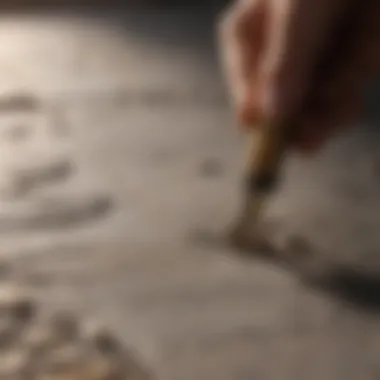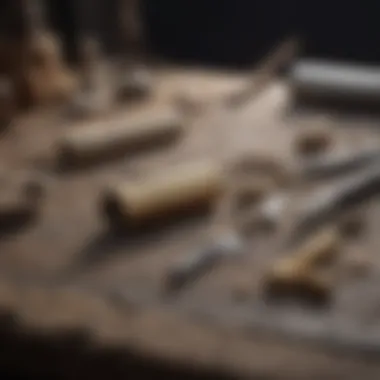Best Adhesive Solutions for Metal-to-Stone Bonding Explained


Rock and Fossil Identification
When considering bonding metal to stone, understanding the types of rocks and fossils is crucial. Various rocks like granite, limestone, and sandstone pose unique challenges due to their diverse compositions. Fossils, ranging from ammonites to trilobites, require delicate handling to avoid damage during the bonding process. Utilizing specialized tools such as magnifiers and hardness picks becomes essential for accurate identification.
Collecting Tips and Techniques
Effective collection practices lay the foundation for successful bonding endeavors. Implementing best practices like obtaining permission for excavation and documenting specimen locations ensure ethical collection. Identifying prime collecting sites with abundant rock and fossil diversity maximizes the potential for finding unique pieces. During extraction, employing techniques like gentle prying and brushing mitigates the risk of breakage.
Preservation and Display
Preserving the integrity of rocks and fossils post-bonding demands precise methodologies. Optimal storage conditions involve controlled humidity levels and protection from direct sunlight to prevent deterioration. Implementing innovative display ideas, such as custom-built shadow boxes or rotating pedestals, enhances the aesthetic appeal and educational value of collections.
Geological Insights
Delving into the geological aspects enriches the understanding and appreciation of bonded rock and fossil specimens. Exploring formations shaped by natural processes like sedimentation and metamorphism unveils the Earth's history in each stone. Unearthing fossils with historical significance, like early vertebrates or plant remains, provides a glimpse into prehistoric life forms. Studying notable discoveries like dinosaur skeletons revolutionizes scientific knowledge and inspires further exploration.
Intro
In the realm of rock and fossil collections, the fusion of metal and stone stands as a pinnacle of craftsmanship and innovation. The art of securely binding these two distinct materials opens up avant-garde possibilities for creators and enthusiasts alike. As we delve into the intricate world of adhesive selection for metal-to-stone bonding, a tapestry of considerations unravels before us. This article serves as a guiding compass for those aiming to elevate their collections through seamless and enduring connections.
Understanding the nuances of metal-to-stone bonding is not merely a technical pursuit; it is a testament to the fusion of art and science. The adhesive chosen plays a pivotal role in the longevity and stability of the bond, imparting both function and aesthetics to the final creation. A misstep in adhesive selection could lead to catastrophic consequences, jeopardizing the integrity of the entire piece. Hence, the significance of this topic transcends mere practicality; it embodies a harmonious blend of precision and creativity.
Embarking on the journey of selecting the optimal adhesive entails an exploration of epoxies, construction adhesives, silicone adhesives, and beyond. Each category brings forth a unique set of properties and applications, beckoning the collector to discern wisely amongst the array of options. Moreover, a deep dive into porosity, weight-bearing capacity, and resistance to environmental elements becomes imperative in making an informed choice. It is this tapestry of variables that underscores the meticulous nature of adhesive selection in metal-to-stone bonding, elevating it to a realm where precision meets passion.
Understanding the Bonding Process
In this segment, we delve into the intricate process of bonding metal to stone, a crucial aspect in achieving durable connections in rock and fossil collections. Understanding the bonding process is essential for enthusiasts seeking to preserve the integrity of their pieces. By comprehending how different materials interact and form strong bonds, collectors can ensure the longevity of their displays. This section will elaborate on key principles, providing valuable insights into the science behind adhesive bonding.


Mechanics of Metal to Stone Bonding
Achieving a reliable bond between metal and stone involves a complex interplay of chemical and physical forces. The adhesive used must penetrate the surfaces to create a secure attachment. Factors such as surface roughness, material composition, and adhesive viscosity play significant roles in determining the bonding strength. Understanding these mechanical aspects is crucial for selecting the most suitable adhesive for each specific bonding project.
Challenges in Bonding Metal to Stone
Bonding metal to stone presents unique challenges due to the stark contrast in properties between the two materials. The disparity in porosity, thermal expansion coefficients, and surface energies can hinder the formation of a strong bond. Additionally, varying rates of weathering and deterioration further complicate the bonding process. Addressing these challenges requires a meticulous selection of adhesives tailored to the specific characteristics of the materials being bonded.
Importance of Choosing the Right Adhesive
The importance of selecting the appropriate adhesive for bonding metal to stone cannot be overstated. A well-suited adhesive not only ensures a strong and lasting bond but also enhances the aesthetic appeal of the final display. Factors such as adhesive flexibility, resistance to environmental factors, and chemical compatibility with the bonded materials are critical considerations. By choosing the right adhesive, collectors can elevate the quality and durability of their metal to stone connections, adding value to their prized collections.
Types of Adhesives
In the realm of bonding metal to stone, the choice of adhesive plays a pivotal role in ensuring a successful and long-lasting connection. Understanding the different types of adhesives available is crucial for rock and fossil enthusiasts aiming for secure and durable bonds. Each type brings its unique characteristics and application methods to the table, catering to specific needs and scenarios. By delving into the world of epoxy resins, construction adhesives, and silicon adhesives, individuals can make informed decisions based on properties, strengths, and compatibility with various materials.
Epoxy Resins
Epoxy resins stand out as a popular choice when bonding metal to stone due to their exceptional strength, durability, and versatility. These adhesives offer high bonding capabilities, creating robust connections that withstand stress and environmental factors. Their ability to fill gaps and resist water, chemicals, and temperature fluctuations make them ideal for a wide range of applications. When using epoxy resins, meticulous surface preparation and accurate mixing ratios are crucial for optimal bond strength. With proper application, epoxy resins can provide reliable and long-lasting adhesion for metal to stone bonding projects.
Construction Adhesives
For bonding metal to stone in structural or load-bearing applications, construction adhesives come into play. Designed to provide strong and enduring bonds, construction adhesives excel in scenarios where weight-bearing capacity and impact resistance are paramount. These adhesives offer excellent adhesion to a variety of surfaces, including metal and stone, ensuring reliable connections over time. It is crucial to choose a construction adhesive that suits the specific requirements of the project, considering factors such as curing time, viscosity, and bond flexibility. With proper selection and application, construction adhesives can deliver long-term stability and support for metal to stone bonding endeavors.
Silicone Adhesives
Silicone adhesives are known for their flexibility, weather resistance, and ease of use when bonding metal to stone. These adhesives provide excellent adhesion on porous surfaces, making them suitable for a variety of materials, including metals and stones. With their ability to withstand extreme temperatures and environmental conditions, silicone adhesives offer durable bonding solutions for both indoor and outdoor applications. When working with silicone adhesives, attention to proper surface preparation and curing time is essential to achieve optimal adhesion and ensure the longevity of the bond. By leveraging the properties of silicone adhesives, individuals can secure metal to stone connections with confidence and precision.


Factors to Consider
When delving into the realm of bonding metal to stone, one must carefully assess several key factors to ensure a successful and durable connection. Firstly, the porosity of the materials plays a crucial role in determining the effectiveness of the adhesive. The degree of absorption and retention capabilities of the surfaces will directly impact how well the adhesive adheres and penetrates to create a strong bond. Understanding the porosity helps in selecting the right adhesive that can compensate for any gaps or irregularities in the materials' surfaces, enhancing the overall bond strength.
Secondly, considering the weight-bearing capacity is imperative to guarantee the structural integrity of the metal-to-stone bond. Different adhesives have varying load-bearing capabilities, so matching the adhesive strength to the weight the bond must support is essential. Overlooking this aspect may result in adhesive failure and potential damage to the bonded materials. Assessing the weight-bearing requirements beforehand ensures the longevity and stability of the connection.
Lastly, evaluating the weather and temperature resistance of the adhesive is fundamental for outdoor or exposed applications. The adhesive's ability to withstand fluctuating weather conditions, such as extreme temperatures, humidity, or UV exposure, is vital for maintaining the bond's integrity over time. Choosing an adhesive with high weather and temperature resistance ensures longevity and stability, particularly in environments with harsh weather elements. By careful consideration of these factors, one can select the most suitable adhesive for a reliable metal-to-stone bond that stands the test of time.
Porosity of Materials
The porosity of materials refers to their ability to absorb and retain liquids or other substances. When bonding metal to stone, understanding the porosity of both surfaces is crucial for achieving a strong and lasting connection. Porous materials, for instance, are more challenging to bond as they can absorb adhesives unevenly, leading to a weaker bond. Non-porous materials, on the other hand, typically provide a more consistent surface for adhesive application, resulting in a stronger bond.
To address varying porosities between metal and stone surfaces, it is recommended to use adhesives that can adapt to different absorption rates. Selecting adhesives specifically formulated for porous materials can help fill gaps and irregularities, improving overall bond strength. Additionally, preparing the surfaces by cleaning and roughening them can enhance adhesive penetration, especially on highly porous surfaces. By understanding and accounting for the porosity of materials, one can maximize the adhesive's effectiveness and create a robust metal-to-stone bond.
Weight-Bearing Capacity
When bonding metal to stone, determining the weight-bearing capacity of the adhesive is critical for ensuring a secure and stable connection. The weight-bearing capacity refers to the maximum load that the adhesive can support without failing. It is essential to match the adhesive strength with the anticipated weight the bond will bear to prevent structural issues or bond failure.
Selecting an adhesive with a higher weight-bearing capacity than required is recommended to provide an additional margin of safety. Factors such as the size and surface area of the bonded materials, as well as the conditions under which the bond will be subjected to stress, should be considered when assessing weight-bearing capacity. By choosing an adhesive that aligns with the specific weight requirements, one can maintain the stability and integrity of the metal-to-stone bond.
Weather and Temperature Resistance
Considering the weather and temperature resistance of the adhesive is crucial when bonding metal to stone, especially for outdoor or exposed applications. Environmental factors such as temperature fluctuations, moisture, and UV exposure can significantly impact the longevity and durability of the bond. Choosing an adhesive with high weather and temperature resistance ensures that the bond remains intact and strong under varying conditions.
Adhesives that are designed to withstand extreme temperatures and moisture levels offer enhanced durability, making them suitable for outdoor use or areas exposed to weather elements. Additionally, UV-resistant adhesives prevent degradation and weakening of the bond due to prolonged sun exposure. By prioritizing weather and temperature resistance in adhesive selection, one can optimize the longevity and performance of the metal-to-stone bond, ensuring a reliable connection in diverse environments.
Application Techniques


In the realm of bonding metal to stone, mastering application techniques is crucial for achieving durable and reliable connections. The meticulous execution of these techniques ensures the integrity and longevity of the bond between disparate materials, elevating the overall quality of the final product. When delving into the realm of adhesive application, several key elements merit consideration. Firstly, the adherence to specific guidelines pertaining to surface preparation plays a pivotal role in enhancing the effectiveness of the bonding process. By meticulously cleaning and degreasing both the metal and stone surfaces, one establishes an optimal foundation for the adhesive to securely attach and create a lasting bond.
Understanding the intricacies of mixing and ratio guidelines further enhances the adhesive's bonding capabilities. Properly adhering to the manufacturer's instructions regarding the correct proportions and thorough blending of adhesive components is paramount. Any deviation from the prescribed ratios can compromise the adhesive's strength and overall performance, emphasizing the significance of precision in this crucial stage of the bonding process.
Curing and setting time stand as critical aspects of adhesive application. Allowing the adhesive sufficient time to cure and set is essential for ensuring the development of maximum bond strength. Rushing this phase may lead to subpar bonding results and potential structural vulnerabilities. Patience in observing the recommended curing durations is key to guaranteeing the adhesive's optimal performance and long-term durability, thereby solidifying the connection between metal and stone for years to come.
Ensuring Durability
Ensuring durability in bonding metal to stone is paramount for long-term structural integrity. The ability of the adhesive to withstand various stresses, such as weight-bearing, environmental conditions, and wear, plays a crucial role in the longevity of the bond. Selecting an adhesive with high durability ensures that the connection remains robust and stable over time. Factors such as the porosity of the materials being bonded and their weight-bearing capacity directly impact the durability of the adhesive bond. Weather and temperature resistance are also vital considerations to guarantee the bond's longevity in outdoor or varying climate settings. Successful durability not only ensures the physical integrity of the bond but also contributes to the overall aesthetic and functional quality of the bonded metal to stone interface, enhancing the visual appeal and usability of the final piece.
Testing Adhesive Strength
Testing adhesive strength is a key aspect of assessing the reliability and performance of the bond between metal and stone. Various methods can be employed to evaluate the adhesive's strength, including tension, shear, and peel tests. These tests help determine the maximum load the bond can withstand before failure occurs, providing critical data on the adhesive's structural integrity. Conducting thorough and meticulous adhesive strength tests ensures that the chosen adhesive meets the desired performance criteria and can endure the specific demands of the metal to stone bonding application. Regular testing and evaluation of adhesive strength are recommended to monitor the bond's stability and anticipate any potential issues that may arise over time, thus proactively addressing maintenance needs and ensuring the durability and longevity of the connection.
Maintenance and Longevity
Maintenance and longevity are essential considerations for preserving the bond between metal and stone. Implementing a proactive maintenance plan, including regular inspections and cleaning, can significantly prolong the lifespan of the adhesive bond. Proper care and maintenance not only help prevent potential damage or deterioration but also ensure the bond retains its strength and stability over the years. Longevity is enhanced by addressing any signs of wear or weakness promptly, such as reapplication of adhesive or reinforcement of the bond when necessary. By prioritizing maintenance and longevity, collectors can safeguard their valuable metal to stone connections, allowing them to enjoy their collections for years to come in optimal condition.
Troubleshooting Common Issues
Despite meticulous planning and application, common issues may still arise in the bonding of metal to stone. Some common problems include inadequate surface preparation, incorrect adhesive selection, or improper application techniques. Troubleshooting these issues requires a structured approach, starting with identifying the root cause of the problem. Resolving common issues often involves revisiting the bonding process, addressing any deficiencies or missteps, and implementing corrective measures to reinforce the bond. By understanding and proactively troubleshooting common bonding issues, collectors can effectively maintain the quality and durability of their metal to stone connections, ensuring long-lasting and secure bonds that withstand the test of time.
End
In delving into the selection process of the best adhesive for bonding metal to stone, we encapsulate a meticulous journey of precision and durability. The conclusion serves as the culmination of a judicious exploration, underscoring crucial facets for rock and fossil enthusiasts embarking on fusion endeavors. Highlighting the significance of the final discernment, this pivotal juncture pivots on concretizing the optimal choice from a spectrum of adhesive possibilities.
As we unwind the layers of this narrative tapestry, it becomes apparent that the essence of the conclusion resonates with practical implications and longevity considerations. Cementing the essence of the thematic weightage accosted throughout this discourse, the conclusion evolves as the cornerstone of informed decision-making in the adhesive selection process.
Furthermore, the conclusion not only offers closure to the deliberative odyssey embarked upon but also renders a roadmap for aficionados navigating the intricate terrain of metal to stone bonding. Manifesting as the nucleus of informed agency, the conclusion proffers a repository of knowledge encapsulated within the annals of adhesive application, resonating a clarion call for precision, coherence, and meticulous foresight in veering towards optimal adhesive choices.
The richness embedded within the conclusion beckons the discerning practitioner towards a symbiosis of theoretical underpinnings and pragmatic considerations, forging an alliance that breeds stalwart bonds between disparate substrates. Moreover, the conclusion stands as a beacon, illuminating the path towards cohesive and enduring bonds, underscoring the imperatives of sustainability, ruggedness, and pragmatism in adhesive selection for metal to stone applications.
Lastly, the conclusion encapsulates not just the cessation of this treatise but the inception of informed action, beckoning forth a cascade of deliberative reflection and purposeful implementation for those who adhere to the intricate craft of adhesion in the realm of rock and fossil preservation.







